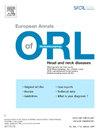感官室:对发育中儿童的听觉和视觉感知进行自然评估。
IF 2.4
4区 医学
Q2 OTORHINOLARYNGOLOGY
European Annals of Otorhinolaryngology-Head and Neck Diseases
Pub Date : 2025-01-01
DOI:10.1016/j.anorl.2024.08.002
引用次数: 0
摘要
导言听觉对于语言学习和理解环境至关重要。了解儿童对听觉和视觉信息的反应对于听力损失的适当管理至关重要。客观和主观评估可以诊断听力损失,但无法测量儿童的自然感知能力。我们开发了一个 "感官室",用于对儿童的感知进行补充评估,以便在适合儿童的生态环境中评估他们对有意义的自然声音和视觉刺激的行为反应:16名听力正常的儿童和10名植入人工耳蜗前患有先天性听力损失的儿童参加了这项可行性研究,他们的年龄在13至32个月之间。他们感知了 18 种环境声音和 9 种视觉刺激,其行为反应被编码为:停止、看、移动、指向、语言或情绪反应:结果:所有儿童都完成了任务,证明了这项任务在儿童中的可行性。听力正常儿童对听觉刺激和视觉刺激的反应百分比没有差异;先天性听力损失儿童对视觉刺激的反应与听力正常儿童相同,但对听觉刺激没有反应。正常听力儿童行为反应的进展与认知和语言发展的年龄相符:感官室 "可以量化儿童对各种听觉和视觉刺激的反应,让临床医生对儿童的感知和处理过程有了可测量的了解。本文章由计算机程序翻译,如有差异,请以英文原文为准。
Sensory room: Naturalistic assessment of auditory and visual perception in developing children
Introduction
Hearing is essential for language acquisition and understanding the environment. Understanding how children react to auditory and visual information is essential for appropriate management in case of hearing loss. Objective and subjective assessments can diagnose hearing loss, but do not measure natural perception in children. We developed a “sensory room” for complementary assessment of children's perceptions so as to assess behavioral responses to meaningful natural sounds and visual stimuli in an ecologic environment suited to children.
Material and methods
Sixteen normal-hearing children and 10 with congenital hearing loss before cochlear implantation, aged 13 to 32 months, were included in this feasibility study. They perceived 18 environmental sounds and 9 visual stimuli, and their behavioral responses were coded accordingly as: stopping, looking, moving, pointing, language or emotional reactions.
Result
All children completed the task, demonstrating its feasibility in children. Percentage responses to auditory versus visual stimuli did not differ in normal-hearing children; those with congenital hearing loss responded like normal-hearing children to visual stimuli, but did not react to auditory stimuli. Progression in normal-hearing children's behavioral responses corresponded to cognitive and linguistic development according to age.
Conclusion
The “sensory room” quantified children's responses to various auditory and visual stimuli, providing clinicians with measurable insight into the children's sensory perception and processing.
求助全文
通过发布文献求助,成功后即可免费获取论文全文。
去求助
来源期刊

European Annals of Otorhinolaryngology-Head and Neck Diseases
OTORHINOLARYNGOLOGY-
CiteScore
3.70
自引率
28.00%
发文量
97
审稿时长
12 days
期刊介绍:
European Annals of Oto-rhino-laryngology, Head and Neck diseases heir of one of the oldest otorhinolaryngology journals in Europe is the official organ of the French Society of Otorhinolaryngology (SFORL) and the the International Francophone Society of Otorhinolaryngology (SIFORL). Today six annual issues provide original peer reviewed clinical and research articles, epidemiological studies, new methodological clinical approaches and review articles giving most up-to-date insights in all areas of otology, laryngology rhinology, head and neck surgery. The European Annals also publish the SFORL guidelines and recommendations.The journal is a unique two-armed publication: the European Annals (ANORL) is an English language well referenced online journal (e-only) whereas the Annales Françaises d’ORL (AFORL), mail-order paper and online edition in French language are aimed at the French-speaking community. French language teams must submit their articles in French to the AFORL site.
Federating journal in its field, the European Annals has an Editorial board of experts with international reputation that allow to make an important contribution to communication on new research data and clinical practice by publishing high-quality articles.
 求助内容:
求助内容: 应助结果提醒方式:
应助结果提醒方式:


